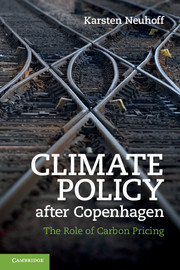Book contents
- Frontmatter
- Contents
- List of figures
- List of tables
- List of boxes
- Acknowledgements
- List of abbreviations
- 1 Introduction
- 2 The role of a climate policy mix
- 3 Implementing a carbon price: the example of cap and trade
- 4 Shifting investment to low-carbon choices
- 5 Co-operation among developed countries: a role for carbon markets?
- 6 A world of different carbon prices
- 7 International support for low-carbon growth in developing countries
- 8 Conclusion
- References
- Index
3 - Implementing a carbon price: the example of cap and trade
Published online by Cambridge University Press: 05 June 2012
- Frontmatter
- Contents
- List of figures
- List of tables
- List of boxes
- Acknowledgements
- List of abbreviations
- 1 Introduction
- 2 The role of a climate policy mix
- 3 Implementing a carbon price: the example of cap and trade
- 4 Shifting investment to low-carbon choices
- 5 Co-operation among developed countries: a role for carbon markets?
- 6 A world of different carbon prices
- 7 International support for low-carbon growth in developing countries
- 8 Conclusion
- References
- Index
Summary
Governments can put a price on carbon either by imposing a tax on carbon emissions (following Pigou 1920) or by using cap-and-trade schemes (following Coase 1960). Both concepts are simple in theory and have been discussed for decades. Ellerman et al. (2010) review the history of emissions trading and refer to Crocker 1966 as the first explicit expression of an emissions market. CO2 tax schemes were set up in Sweden in 1991 and subsequently in Denmark, Finland, the Netherlands and Norway, while cap-and-trade schemes for SO2 and NOX were established in the USA during the same period.
Cap-and-trade schemes have four basic components. (i) Governments set a cap on the total volume of emissions of a pollutant and create the corresponding volume of allowances. (ii) These allowances are distributed for nothing or sold to companies and individuals. (iii) The allowances can then be freely traded. This creates, in principle, economic efficiency. Companies that would face high costs to reduce their emissions will buy allowances from companies with lower costs, thus reducing the total cost of emissions reduction. (iv) Emissions are monitored and reported and, at the end of the accounting period, companies have to surrender to government allowances proportional to the volume of their emissions and can bank remaining allowances to the following year.
Information
- Type
- Chapter
- Information
- Climate Policy after CopenhagenThe Role of Carbon Pricing, pp. 56 - 96Publisher: Cambridge University PressPrint publication year: 2011
